As a veterinarian, I often get asked about the safety of certain foods for dogs. One common question is, “Is cilantro bad for dogs?” Cilantro leaves are actually safe for dogs to eat in moderation. However, it’s important to be aware of potential issues and introduce cilantro slowly into your dog’s diet. Let’s explore the topic of cilantro and its impact on dogs.
Key Takeaways:
- Cilantro leaves are safe for dogs to eat in moderation.
- Introduce cilantro slowly into your dog’s diet and monitor for any adverse reactions.
- Feeding too much cilantro can lead to gastrointestinal upset in some dogs.
- Consult with a veterinarian before incorporating new foods into your dog’s diet.
- Cilantro can provide benefits for dogs, but it should not be the main source of nutrition.
Can Dogs Have Cilantro?
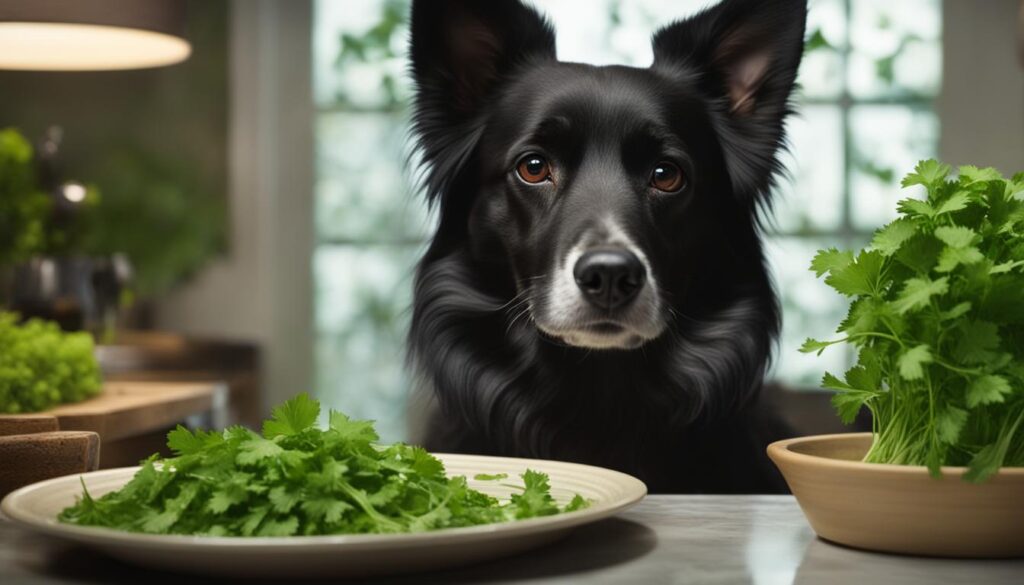
Dogs can have cilantro, but it’s important to keep a few things in mind. While cilantro is not toxic to dogs, not all dogs may enjoy the taste. It is recommended to introduce cilantro slowly into a dog’s diet and monitor for any adverse reactions.
Cilantro should only be fed to dogs in small quantities. Feeding too much cilantro can lead to gastrointestinal upset, such as vomiting or diarrhea. If your dog shows signs of cilantro poisoning, it is crucial to contact a veterinarian for immediate assistance.
Can Dogs Eat Cilantro Safely?
Yes, dogs can eat cilantro safely, but it should be given in moderation. Some dogs may have allergies or sensitivities to cilantro, so it’s essential to pay attention to your dog’s reaction when introducing this herb into their diet.
“While cilantro is not toxic to dogs, it should only be fed in small quantities.”
If you notice any signs of allergies, such as itching, rashes, or respiratory issues, it’s best to consult with a veterinarian. They can help determine if cilantro is suitable for your dog or if there are any other alternative herbs that may be better suited to their dietary needs.
To summarize, while cilantro is generally safe for dogs, it should be fed in moderation, and any adverse reactions should be promptly addressed by a veterinarian. Now let’s explore the benefits of cilantro for dogs in the next section.
Benefits of Cilantro for Dogs

Cilantro offers several benefits for dogs, contributing to their overall health and well-being. It contains essential nutrients such as calcium, magnesium, vitamin K, vitamin A, and vitamin C, which are vital for various aspects of canine health.
One of the key benefits of cilantro is its support for bone health. The calcium and magnesium found in cilantro help to maintain strong and healthy bones in dogs.
Cilantro also aids in promoting skin and fur health. The vitamins A and C present in cilantro support the maintenance of healthy skin and a shiny coat in dogs.
Additionally, cilantro is beneficial for eye health. The vitamin A content in cilantro helps to maintain proper eye function and vision in dogs.
Moreover, cilantro plays a role in boosting the immune system of dogs. The vitamin C and other nutrients present in cilantro support immune function, helping dogs stay healthy and fight off illness.
It is important to note that while cilantro is beneficial for dogs, it should not make up a significant portion of their diet. Cilantro should be fed in moderation, alongside a balanced and nutritionally complete canine diet.
Nutritional Content of Cilantro
| Nutrient | Amount per 100g |
|---|---|
| Calcium | 67mg |
| Magnesium | 26mg |
| Vitamin K | 310μg |
| Vitamin A | 393μg |
| Vitamin C | 27.4mg |
Safe Ways to Feed Cilantro to Dogs
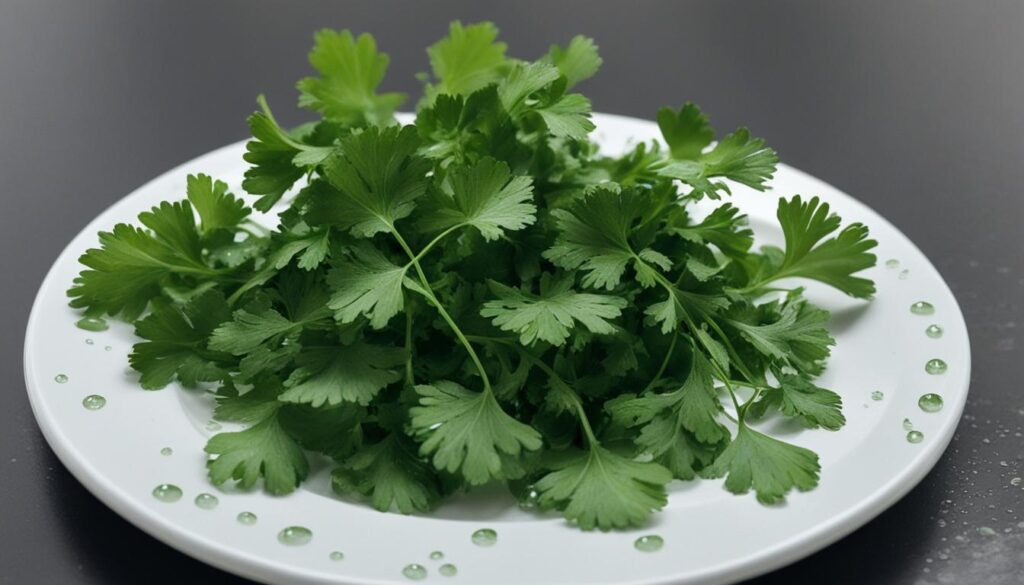
When it comes to feeding cilantro to your dog, it’s important to follow some safe practices to ensure their well-being. While cilantro leaves are generally safe for dogs, there are a few considerations to keep in mind.
Avoid the Stems
When preparing cilantro for your dog, it’s best to use only the leaves and avoid the stems. The stems can be difficult to digest and may cause gastrointestinal issues in some dogs. By sticking to the leaves, you can minimize the risk of any potential digestive discomfort.
Dice and Garnish
Cilantro can be diced and used as a garnish on your dog’s regular food. This can add a burst of flavor and enticing aroma that may encourage your dog to eat. However, it’s important to use cilantro as a topping in moderation, so it doesn’t overpower the main meal.
Incorporate Into Homemade Treats
Another way to include cilantro in your dog’s diet is by incorporating it into homemade treats. There are plenty of recipes available that use cilantro as an ingredient. These treats can be a fun and tasty way to introduce the herb into your dog’s diet while also providing the benefits of other nutritious ingredients.
Monitor Your Dog’s Reaction
As with any new food, it’s crucial to monitor your dog’s reaction when feeding them cilantro. Keep an eye out for any signs of stomach irritation or food aversion, such as vomiting or diarrhea. If you notice any adverse reactions, it’s best to discontinue feeding cilantro and consult with a veterinarian.
Cautions When Feeding Cilantro to Dogs
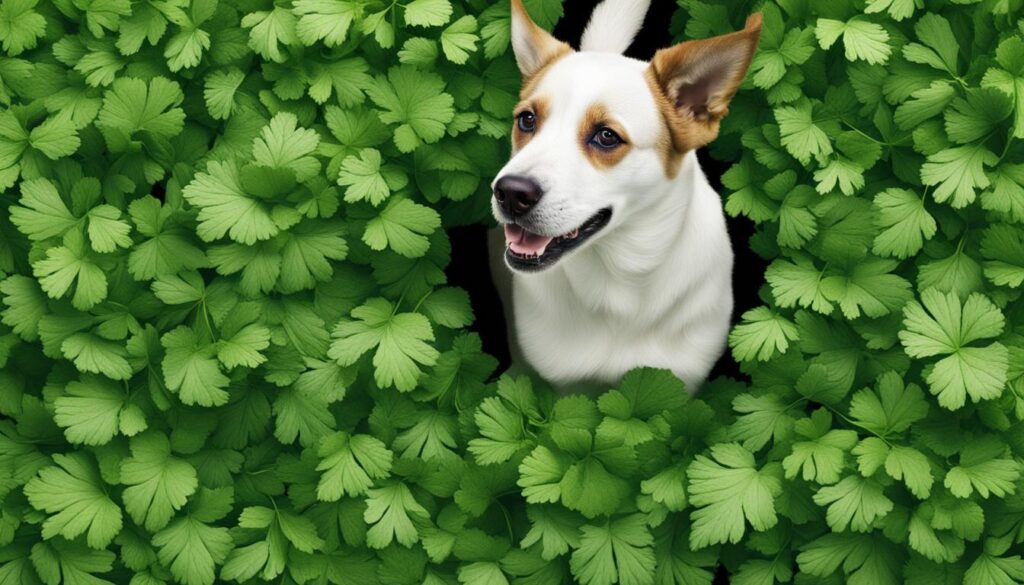
While cilantro is generally safe for dogs, it is essential to exercise caution when incorporating it into their diet. Cilantro should not be the main source of nutrition for dogs and should only be fed in small quantities. Feeding excessive amounts of cilantro can lead to gastrointestinal upset, causing discomfort and digestive issues.
As a responsible pet owner, it is crucial to prioritize a balanced and appropriate diet for your furry companion. While cilantro can provide some health benefits, it should not replace essential nutrients derived from a well-rounded canine diet.
I cannot stress enough the importance of consulting with a veterinarian before introducing new foods or supplements into your dog’s diet. A veterinary professional can provide personalized guidance based on your dog’s specific nutritional needs and any underlying health conditions they may have.
Uncontrolled cilantro consumption in dogs can lead to:
- Gastrointestinal upset
- Diarrhea
- Vomiting
- Food aversion
Monitoring your dog’s reaction to cilantro consumption is crucial. If you notice any adverse effects such as stomach irritation or a reluctance to eat, it is essential to discontinue feeding cilantro immediately and consult with your veterinarian.
Remember, each dog is unique, and their dietary requirements may vary. It is always better to be cautious and seek professional advice when introducing new foods to ensure the well-being and health of your beloved companion.
Expert Advice:
“While cilantro is generally safe for dogs, it should be given in moderation and not constitute a significant portion of their diet. Always consult with your veterinarian to ensure you are meeting your dog’s nutritional needs and to address any concerns or questions you may have.”
– Dr. Emily Johnson, DVM
Guidelines for Feeding Cilantro to Dogs
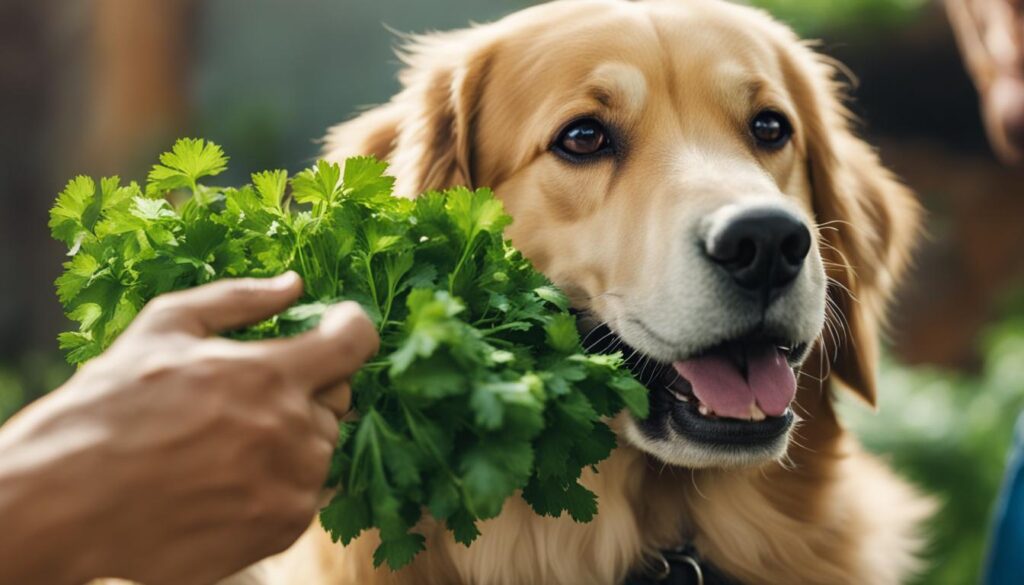
When introducing cilantro to a dog’s diet, it is important to follow a few guidelines to ensure their health and well-being. Here are some key considerations:
- Start with a small pinch: Begin by adding a small pinch of cilantro to your dog’s food. This allows them to become familiar with the taste and texture without overwhelming their taste buds.
- Gradually increase the amount: Over time, gradually increase the amount of cilantro you incorporate into their meals. This helps their digestive system adjust and reduces the risk of any adverse reactions.
- Do not exceed one teaspoon per day: While cilantro can provide health benefits, it is important not to overdo it. Avoid feeding your dog more than one teaspoon of cilantro per day to prevent any potential digestive issues.
- Adjust the amount based on size: Consider your dog’s size when determining the appropriate amount of cilantro to feed. Smaller dogs will require less cilantro compared to larger breeds.
- Monitor for adverse reactions: Keep a close eye on your dog after introducing cilantro into their diet. Watch for any signs of cilantro sensitivities, such as vomiting, diarrhea, or decreased appetite.
Remember, every dog is different, and some may have sensitivities to cilantro. If you notice any negative reactions, it is important to discontinue feeding cilantro and consult with your veterinarian for personalized guidance.
Benefits of Moderation
Feeding cilantro to dogs in moderation allows them to enjoy its potential health benefits without overwhelming their digestive system. It is always better to err on the side of caution and monitor your dog’s reaction to cilantro to ensure their well-being.
The Health Benefits of Cilantro for Dogs
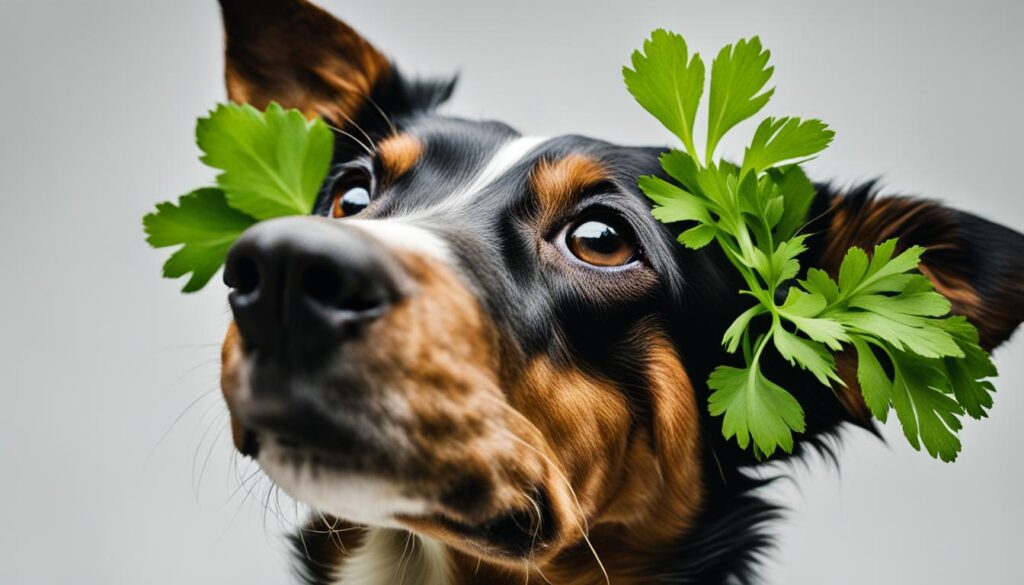
Cilantro can offer several health benefits for dogs. It contains natural compounds with anti-fungal and anti-bacterial properties, which can help fight infections in the digestive system.
The consumption of cilantro can also have positive effects on a dog’s oral health. It can freshen their breath and prevent gum infections, promoting overall dental hygiene.
Cilantro is not only a flavorful herb but also a nutritional powerhouse for dogs. It is rich in essential vitamins and minerals that support their overall well-being. These include calcium, magnesium, vitamin K, vitamin A, and vitamin C. These nutrients contribute to bone health, skin and fur health, eye health, and immune function in dogs.
In addition, cilantro acts as an antioxidant, protecting the cells from damage caused by harmful free radicals. It also aids in digestion by promoting a healthy gut environment and supporting proper nutrient absorption.
Furthermore, cilantro has been shown to have detoxifying properties in dogs. It can help eliminate toxic metals from the body and support overall detoxification processes.
To illustrate the health benefits of cilantro for dogs, here is a table outlining the key nutrients found in cilantro and their respective functions:
| Nutrient | Function |
|---|---|
| Calcium | Supports bone health |
| Magnesium | Contributes to muscle and nerve function |
| Vitamin K | Aids in blood clotting and bone health |
| Vitamin A | Promotes healthy vision and skin |
| Vitamin C | Supports immune function and acts as an antioxidant |
It is important to note that while cilantro provides health benefits, it should be incorporated into a dog’s diet in moderation. It should not replace their regular meals and should be offered as a supplement or occasional treat.
In the next section, we will discuss safe ways to feed cilantro to dogs to ensure their well-being.
The Importance of Moderation
While cilantro has health benefits for dogs, it is important to feed it in moderation. Feeding excessive amounts of cilantro can have harmful effects on dogs and lead to gastrointestinal issues and other adverse reactions. Therefore, it should never replace a dog’s regular diet, as it can unbalance their nutritional intake.
Dogs have different sensitivities and responses to cilantro, so it is crucial to be aware of their individual tolerance. Feeding small quantities of cilantro ensures that dogs can enjoy its potential benefits without experiencing any negative effects. By incorporating cilantro as part of a varied and balanced diet, dogs can reap its nutritional advantages.
Feeding dogs an excessive amount of cilantro can result in digestive problems such as upset stomach, vomiting, or diarrhea. These harmful effects can be avoided by adhering to appropriate portion sizes and monitoring a dog’s reaction to cilantro consumption. If any adverse symptoms are observed, it is advisable to consult with a veterinarian for guidance.
Remember, cilantro is just one component of a dog’s overall nutritional needs. A well-rounded diet that includes a variety of nutritious foods is essential for their health and well-being. If you have any concerns or questions about incorporating cilantro into your dog’s diet, consult with a veterinarian who can provide personalized guidance based on your dog’s specific needs and sensitivities.
Summary of Dos and Don’ts for Feeding Cilantro to Dogs
| Do | Don’t |
|---|---|
| Feed cilantro in moderation | Replace a dog’s regular diet with cilantro |
| Introduce cilantro slowly | Feed excessive amounts of cilantro |
| Monitor a dog’s reaction to cilantro | Ignore any adverse symptoms |
| Consult with a veterinarian for guidance | Assume all dogs have the same sensitivity to cilantro |
By following these guidelines and being mindful of the importance of moderation, you can safely incorporate cilantro into your dog’s diet and provide them with potential health benefits without causing harm.
How to Safely Incorporate Cilantro into Your Dog’s Diet
To ensure the safe inclusion of cilantro in your dog’s diet, it is important to introduce it gradually and in small quantities. This will allow you to monitor your dog’s reaction and ensure they tolerate it well. Here are a few ways to incorporate cilantro safely:
- Add Diced Cilantro as a Garnish: Diced cilantro can be sprinkled as a garnish on top of your dog’s regular food. This not only adds flavor but also introduces the herb in a controlled manner.
- Create Homemade Treats: You can incorporate cilantro into homemade dog treat recipes. This allows you to control the ingredients and ensure your dog’s safety while enjoying the benefits of cilantro.
Remember, when introducing any new food to your dog’s diet, it is always recommended to consult with your veterinarian. They can provide personalized guidance and ensure that cilantro is safe and suitable for your individual dog.
Monitoring for Adverse Reactions
While cilantro is generally safe for dogs, it is essential to monitor your dog for any adverse reactions. Some dogs may have sensitivities or allergies to cilantro, which can manifest as digestive upset or other symptoms. If you notice any signs of discomfort or negative reactions, discontinue feeding cilantro and consult with your veterinarian.
By gradually introducing cilantro, monitoring for adverse reactions, and seeking professional guidance, you can safely incorporate this herb into your dog’s diet while ensuring their well-being.
| Benefits of Safely Incorporating Cilantro into Your Dog’s Diet |
|---|
| Provides essential vitamins and minerals |
| Supports bone, skin, and eye health |
| Acts as an antioxidant |
| Promotes healthy digestion |
| Aids in eliminating toxic metals from the body |
Consulting a Veterinarian
When it comes to introducing cilantro or any new food to your dog’s diet, consulting a veterinarian is essential. The expertise of a veterinarian can provide valuable guidance on the appropriate amount of cilantro to feed your dog. They can also address any potential risks or concerns based on your dog’s individual health needs.
A veterinarian’s knowledge extends to identifying any allergies or sensitivities your dog may have to cilantro. If your dog exhibits any adverse reactions after consuming cilantro, such as vomiting, diarrhea, decreased appetite, or digestive issues, it is crucial to seek veterinary assistance.
Through a comprehensive evaluation, a veterinarian can determine whether cilantro is suitable for your dog and recommend alternative options if necessary. They will also provide personalized advice on incorporating cilantro into your dog’s diet safely and in moderation.
Seeking Professional Advice for Your Dog’s Wellbeing
Your dog’s health and wellbeing should always be a top priority. A veterinarian can provide the necessary expertise and guidance to ensure your dog’s safety when it comes to cilantro consumption. By working collaboratively with a veterinarian, you can make informed decisions and provide the best possible care for your furry friend.
| Benefits of Consulting a Veterinarian | Importance of Veterinary Care |
|---|---|
| Expert guidance on cilantro consumption | Individualized healthcare advice |
| Identification of cilantro allergies or sensitivities | Early detection of potential health concerns |
| Recommendation of alternative options if necessary | Professional supervision during dietary changes |
Consulting a veterinarian ensures that you can make well-informed decisions regarding your dog’s diet and overall health. Their expertise and personalized care will help you navigate the complexities of cilantro consumption, ensuring the safety and wellbeing of your beloved canine companion.
Potential Adverse Reactions to Cilantro
While cilantro is generally safe for dogs, some may have allergies or sensitivities to this herb. It is important to be aware of the potential adverse reactions that dogs may experience after consuming cilantro.
Common adverse reactions to cilantro in dogs may include:
- Vomiting
- Diarrhea
- Decreased appetite
- Digestive issues
If your dog exhibits any of these symptoms after consuming cilantro, it is crucial to seek veterinary assistance for further evaluation and guidance. A veterinarian can determine if your dog has a specific sensitivity or allergy to cilantro and recommend appropriate steps to manage and avoid future reactions.
Remember, each dog is unique, and while cilantro may be well-tolerated by most dogs, it can still cause adverse effects in some. It is always best to err on the side of caution and consult with a veterinarian if you have any concerns about your dog’s reaction to cilantro or any other food.
Summary of Potential Adverse Reactions to Cilantro in Dogs
| Adverse Reactions | Description |
|---|---|
| Vomiting | Expelling stomach contents forcefully through the mouth. |
| Diarrhea | Abnormally loose or watery feces. |
| Decreased appetite | Loss of interest in or reduced consumption of food. |
| Digestive issues | Discomfort or disruption of the digestive system, such as abdominal pain, gas, or bloating. |
Wrapping Up
In conclusion, cilantro is generally safe for dogs to consume in moderation. While it can provide various health benefits, it should not make up a significant portion of a dog’s diet. Feeding too much cilantro can lead to gastrointestinal upset and other adverse reactions in some dogs. Therefore, it is important to introduce cilantro slowly into a dog’s diet and monitor for any adverse reactions.
If you decide to include cilantro in your dog’s diet, it is recommended to use only the leaves and avoid the stems, as they can be difficult to digest. Cilantro can be added as a garnish on your dog’s food or used in homemade treat recipes. However, it is important to remember that cilantro should not replace a balanced and complete dog food diet.
If you have any concerns or questions about feeding cilantro to your dog, it is always best to consult with a veterinarian. They can provide you with personalized guidance based on your dog’s individual needs and health condition. Consulting a veterinarian will help ensure that you are making the best choices for your dog’s overall health and well-being.
FAQ
Can dogs have cilantro?
Yes, dogs can have cilantro. The leaves are safe for dogs to eat in moderation, but it should only be fed in small quantities.
What are the benefits of cilantro for dogs?
Cilantro is a good source of calcium, magnesium, vitamin K, vitamin A, and vitamin C. These nutrients support bone health, skin and fur health, eye health, and immune function in dogs.
How can I safely feed cilantro to my dog?
When feeding cilantro to a dog, it is best to use only the leaves and avoid the stems. The stems can be difficult to digest and may cause gastrointestinal issues in some dogs. Cilantro can be diced and used as a garnish on a dog’s food or incorporated into homemade dog treat recipes.
Are there any cautions when feeding cilantro to dogs?
While cilantro is generally safe for dogs, it should not be the main source of nutrition and should only be fed in small quantities. Feeding too much cilantro can lead to gastrointestinal upset.
What are the guidelines for feeding cilantro to dogs?
When introducing cilantro to a dog’s diet, start with a small pinch mixed into their food. Gradually increase the amount over time, but do not exceed more than one teaspoon of cilantro per day. The amount should also be adjusted based on the size of the dog.
Should I consult a veterinarian before feeding cilantro to my dog?
Yes, it is important to consult with a veterinarian before feeding cilantro or any new food to a dog. A veterinarian can provide guidance on the appropriate amount of cilantro to feed, as well as any potential risks or concerns based on the dog’s individual health needs.
What are the potential adverse reactions to cilantro in dogs?
Some dogs may have allergies or sensitivities to cilantro. Adverse reactions can include vomiting, diarrhea, decreased appetite, or digestive issues. If a dog experiences any negative reaction after consuming cilantro, it is important to contact a veterinarian for further evaluation and guidance.






